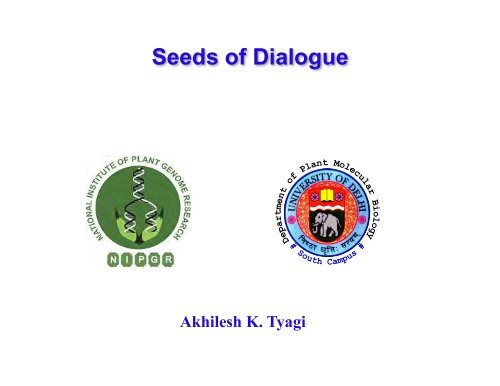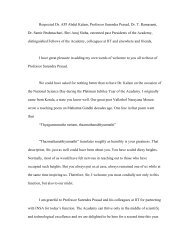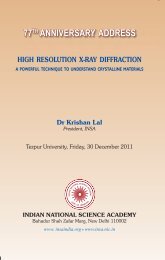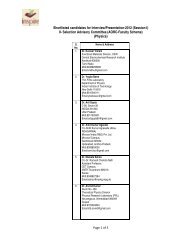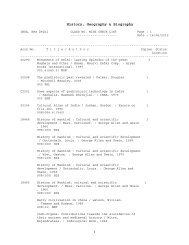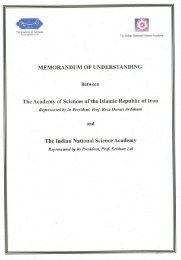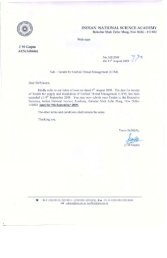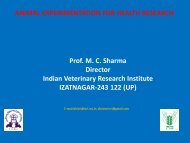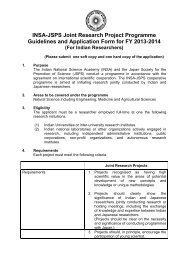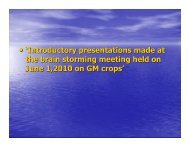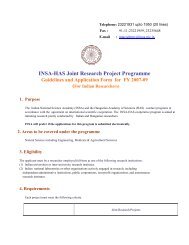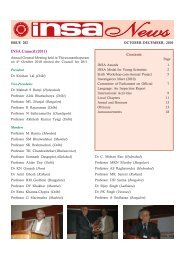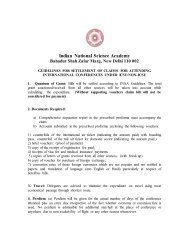By Prof. Akhilesk K. Tyagi - Indian National Science Academy
By Prof. Akhilesk K. Tyagi - Indian National Science Academy
By Prof. Akhilesk K. Tyagi - Indian National Science Academy
Create successful ePaper yourself
Turn your PDF publications into a flip-book with our unique Google optimized e-Paper software.
Seeds of Dialogue<br />
Akhilesh K. <strong>Tyagi</strong>
Genetically Modified Food<br />
• Humans have<br />
been genetically<br />
modifying plants<br />
for a very long<br />
time:<br />
– Selective breeding<br />
– Cross pollination<br />
– hybridization
Per capita availability of food grains<br />
186<br />
197<br />
189<br />
208<br />
191<br />
199<br />
kgs<br />
140
Food Demand of India<br />
Item<br />
Production<br />
2010 (in MT)<br />
Demand<br />
2020 (in MT)<br />
Rice 95.32 122.1<br />
Wheat 85.93 102.8<br />
Coarse cereals 42.22 45.9<br />
Pulses 18.09 27.8<br />
Food grains 241.56 298.6
Why GM Crops?<br />
‣ Protection against yield loss due to stress<br />
‣ To improve nutrition/quality<br />
‣ For post-harvest gain<br />
‣ For more yield<br />
‣ To create bio-factories<br />
‣ Premium for quality<br />
‣ Reduction in insecticide or fertilizer use
What are potential disadvantages of<br />
growing GM Crops?<br />
‣ Biosafety<br />
‣ Environmental safety<br />
‣ Economic value<br />
‣ Option to choose<br />
‣ Ethical issues
Who has grow them and how much?
Global Area of Biotech Crops, 1996 to 2012:<br />
Industrial and Developing Countries (M Has, M Acres)<br />
ISAAA<br />
M Acres<br />
445 180<br />
395 160<br />
346 140<br />
296 120<br />
Total<br />
Industrial<br />
Developing<br />
247 100<br />
198<br />
80<br />
148<br />
60<br />
99<br />
40<br />
49<br />
20<br />
0<br />
0<br />
1996 1997 1998 1999 2000 2001 2002 2003 2004 2005 2006 2007 2008 2009 2010 2011 2012<br />
Source: Clive James, 2012
Global Area of Biotech Crops, 1996 to 2012:<br />
<strong>By</strong> Crop (Million Hectares, Million Acres)<br />
ISAAA<br />
M Acres<br />
198<br />
173<br />
148<br />
124<br />
99<br />
74<br />
49<br />
25<br />
0<br />
90<br />
80<br />
70<br />
60<br />
50<br />
40<br />
30<br />
20<br />
10<br />
0<br />
Soybean<br />
Maize<br />
Cotton<br />
Canola<br />
1996 1997 1998 1999 2000 2001 2002 2003 2004 2005 2006 2007 2008 2009 2010 2011 2012<br />
Source: Clive James, 2012
Global Area of Biotech Crops, 1996 to 2012:<br />
<strong>By</strong> Trait (Million Hectares, Million Acres)<br />
ISAAA<br />
M Acres<br />
297<br />
247<br />
198<br />
148<br />
99<br />
120<br />
100<br />
80<br />
60<br />
40<br />
Herbicide Tolerance<br />
Insect Resistance (Bt)<br />
Herbicide Tolerance/<br />
Insect resistance<br />
49<br />
20<br />
0<br />
0<br />
1996 1997 1998 1999 2000 2001 2002 2003 2004 2005 2006 2007 2008 2009 2010 2011 2012<br />
Source: Clive James, 2012
Global Adoption Rates (%) for Principal<br />
Biotech Crops (Million Hectares, Million Acres), 2012<br />
ISAAA<br />
M Acres<br />
445<br />
395<br />
346<br />
180<br />
160<br />
140<br />
Conventional<br />
Biotech<br />
159<br />
296<br />
247<br />
120<br />
100<br />
100<br />
198<br />
80<br />
148<br />
60<br />
99<br />
40<br />
30<br />
31<br />
49<br />
20<br />
0<br />
0<br />
81%<br />
Soybean<br />
81%<br />
Cotton<br />
35%<br />
Maize<br />
30%<br />
Canola<br />
Source: Clive James, 2012
Biotech Crop Countries and Mega-Countries, 2012<br />
ISAAA
ISAAA
Bt Cotton in India<br />
‣ 10.8 million ha out of 12 million ha<br />
‣ >6 million farmers<br />
‣ 33 million bales<br />
‣ 50% increase in yield<br />
‣ 50% reduction in spray of insecticide<br />
‣ 30% increase in income
Why Bttechnology in brinjal?<br />
Adult<br />
moth<br />
Egg<br />
3 days<br />
Hatching<br />
Achilles’<br />
Heel<br />
Entry<br />
Or Bttechnology?<br />
2 to 3 hours<br />
9 to 14 days<br />
Mature<br />
Larva<br />
Cocoon<br />
Adult<br />
emergence<br />
7-9 days<br />
Pupation<br />
Farmer’s Dilemma: Repeated pesticides prays?
Some important transgenic crop plants developed / tested by<br />
public research institutions in India<br />
Crop Trait Institution<br />
___________________________________________________________________________<br />
1. Brinjal Insect resistance IVRI Varanasi, NRCPB, TNAU, UAS Dharwad<br />
2. Chickpea Insect resistance Assam Agricultural University Jorhat,<br />
BI, ICRISAT Hyderabad, NRCPB<br />
3. Cotton Insect resistance Central Institute of Cotton Research, Nagpur<br />
NBRI, UAS Dharwad<br />
4. Groundnut Disease resistance ICRISAT, Hyderabad<br />
5. Mustard Male sterility DUSC<br />
6. Potato Disease resistance CPRI<br />
7. Potato Cold-sweetening CPRI<br />
8. Potato Protein quality NIPGR<br />
9. Rice Insect resistance BI, CU, DRR, NRCPB<br />
10. Rice Pro Vitamin A CU, DRR, IARI, TNAU<br />
11. Rice High iron CU<br />
12. Rice Abiotic stress BI, CU, ICGEB, MSSRF, DUSC<br />
13. Rice Fungal disease CU, MKU, TNAU<br />
14. Sorghum Insect resistance NRC for Sorghum, Hyderabad<br />
15. Sugarcane Insect resistance Sugarcane Breeding Institute, Coimbatore<br />
16. Tomato Slow ripening NIPGR, NRCPB<br />
17. Tomato Virus resistance IARI<br />
18. Tomato Edible vaccine DUSC
Golden rice -Vitamin A deficiency<br />
Ingo Potrykus<br />
co inventor<br />
Problem : Rice is major Staple and does not contain<br />
Provitamin A<br />
Consequences: 400 million rice eating poor suffer from<br />
vitamin A deficiency ; 6000 die per day and 500, 000<br />
become blind every year<br />
Answer : Biofortification : improvement of the<br />
micronutrient content of the crops on genetic basis<br />
Golden rice contains genes introduced<br />
through genetic engineering required to<br />
activate the biochemical pathway leading to<br />
accumulation of<br />
pro-vitamin A<br />
<strong>Indian</strong> Rice lines with 8- 25 µg/ gram of<br />
rice produced by breeding and ready for<br />
field testing<br />
Lines with 16µg/ gram of rice are enough<br />
to meet 50 percent of RDA<br />
25µg/gram<br />
8µg/gram
Development of GM potatoes with enhanced nutritive value<br />
by tuber-specific expression of a seed protein AmA1<br />
(Amaranth Albumin 1)<br />
•up to 60% increase in total protein content in seven<br />
genotypic backgrounds suitable for cultivation in<br />
different agro-climatic regions.<br />
•the concentrations of several essential amino acids<br />
were increased significant in transgenic tubers.<br />
•enhanced photosynthetic activity with a concomitant<br />
increase in total biomass.<br />
•a moderate increase in tuber yield.<br />
•field performance and safety evaluation indicate that<br />
the transgenic potatoes are suitable for commercial<br />
cultivation.<br />
______________________________________________<br />
______<br />
Thus, introduction of AmA1 is expected to provide a basis for<br />
commercial production of nutritive value added crops
Enhancement of fruit shelf life by silencing N-glycan processing<br />
enzymes (alpha-mannosidase and beta-hexosaminidase)<br />
Climacteric fruit (tomato)<br />
Ethylene is necessary for ripening<br />
Non-climacteric fruit (capsicum)<br />
Ethylene is not necessary for ripening<br />
Control RNAi-α-Man RNAi-β-Hex<br />
Vec control<br />
RNAi-α-Man<br />
RNAi-β-Hex<br />
Days<br />
20 10<br />
Days<br />
15<br />
5<br />
10<br />
RNAi mediated silencing of α-man and β-hex genes together to<br />
enhance shelf-life of fruits<br />
Not I<br />
CaMV 35S promoter<br />
Kpn I<br />
EcoR I<br />
Xho I<br />
PDK intron<br />
Xba I<br />
Bam HI<br />
Hind III<br />
Cla I<br />
Not I<br />
OCS terminator<br />
subcloned into pART27 and<br />
transformed to tomato<br />
Hex Man<br />
Sense direction<br />
cloning<br />
Hex Man<br />
Antisense direction<br />
cloning<br />
RNAi Cassette in pHANNIBAL<br />
α-man and β-hex<br />
suppressed<br />
transgenic plants
Grain Yield: UBI:OsSAP1 lines under water-deficit Stress<br />
160<br />
Soil moisture- 8-9%<br />
Number of filled grains<br />
140<br />
120<br />
100<br />
80<br />
60<br />
40<br />
20<br />
0<br />
WT-US WT-Str S10-US S10-Str<br />
WT (US) WT (Str) S-10 (US) S-10 (Str)
GMOs approved so far in India<br />
Agriculture<br />
Healthcare<br />
(Recombinant<br />
Therapeutics)<br />
Bt Cotton from Monsanto, USA<br />
Bt Cottonfrom IIT, Kharagpur<br />
Bt CottonCtt fromf Biocentury,Bit ChinaChi<br />
Bt Cotton from Metahelix, Bangalore<br />
Bt Cotton from CICR, Nagpur<br />
A Total of 20 products including<br />
‐Human insulin for diabetes<br />
‐Hepatitis B Vaccine<br />
‐Human growth hormone<br />
‐Streptokinase for acute myocardial infraction<br />
‐Teriparatide(Forteo) for Osteoporosis<br />
‐Platelet Derived Growth Factor (PDGF) for Bone<br />
marrow induction & Osteoblastsproliferation<br />
‐Follicle Stimulating Hormone for reproductive<br />
disorders
Who regulates them and how?
Guiding Principles for International<br />
Regulatory Systems<br />
‣ Substantial Equivalence<br />
‣ Principle of Familiarity<br />
‣ Generally Regarded as Safe (GRAS)<br />
‣ Cartagena Protocol on Biosafety<br />
‣ International Plant Protection Convention<br />
‣ Codex Alimentarius<br />
‣ Agreement as the Application of Sanitary and Phyto-sanitary<br />
Measures<br />
‣ Agreement as Technical Barriers of Trade<br />
‣ Agreement on Trade related Aspects of Intellectual Property<br />
Rights<br />
‣ United Nations Convention on Biological Diversity
<strong>Indian</strong> Regulatory System<br />
‣ To ensure that GM crops pose no risk to food safety,<br />
environmental safety and agriculture productivity<br />
‣ To demonstrate potential benefits over the conventional<br />
variety/hybrid in terms of economic benefit to the farmer<br />
and/or the environment<br />
‣ To generate quantitative biological, ecological and agronomic<br />
supportive data<br />
‣ Rules and guidelines formulated to achieve above objectives
Regulation of GM Foods in India<br />
‣ Under Environment Protection Act (1986), MoEf rules<br />
formulated in 1989 created six competent authorities namely<br />
RDAC, RCGM, IBSC; GEAC, SBCC, DLC; MEC for field trials under<br />
RCGM and GEAC<br />
‣ Recombinant DNA Safety Guidelines 1990, modified 1994<br />
‣ DBT Revised Guidelines for Research on Transgenic Plants –<br />
1998, also includes guidelines for toxicity & allergenecity<br />
evaluation of transgenic seeds, plants & plant parts<br />
‣ Safety Assessment of GM Food Crops -2007, modified 2009<br />
‣ Guidelines for the Safety Assessment of Foods Derived from GE<br />
plants – 2008<br />
‣ Guidelines & SOPs for Confined Field Trials of Regulated<br />
Genetically Engineered Plants – 2008<br />
‣ Event Based Approval Mechanism (EBAM)- 2009
Consult : http://igmoris.nic.in<br />
<strong>Indian</strong> GMO Research Information<br />
<strong>Indian</strong> GMO Research Information System (IGMORIS) is a web<br />
based database on activities involving the use of GMOs and<br />
products thereof in India.<br />
make available objective and realistic scientific information<br />
relating to GMOs and products thereof under research, trials and<br />
commercial use pertaining to agriculture, pharmaceuticals,<br />
environment and industrial products to all stakeholders including<br />
scientists, regulators, industry and the public in general.
Lessons learnt…..<br />
Regulatory<br />
Frame<br />
work<br />
PUBLIC<br />
POLICY<br />
Public<br />
concerns<br />
<strong>Science</strong> of<br />
risk<br />
assessment
METHODOL0GY ADOPTED BY DBT FOR<br />
ESTABLISHMENT OF BRAI<br />
Step 1<br />
Review of the<br />
structure and<br />
governance of other<br />
autonomous<br />
agencies in India<br />
Review of<br />
international<br />
models for the<br />
regulation of<br />
biotechnology<br />
Review of India’s<br />
international<br />
obligations<br />
pertinent to the<br />
BRAI’s mandate<br />
Step 2<br />
Step 3<br />
Step 4<br />
Development of a model for the BRAI that addresses:<br />
1. Scope of the regulatory mandate of the BRAI<br />
2. Structure of the BRAI: programs and operations<br />
3. Legal framework and other issues<br />
Preparation of a preliminary establishment plan for the BRAI.<br />
Stakeholder interviews to obtain feedback on the preliminary plan.<br />
Preparation of a revised, draft plan incorporating stakeholder feedback.<br />
Preparation of draft legislation for establishing the BRAI<br />
Step 5<br />
Consultative process with various stakeholders
KEY FEATURES OF BRAI BILL, 2011<br />
The proposed statutory independent regulator that is<br />
the Biotechnology Regulatory Authority of India (BRAI)<br />
would be a nodal agency of the Government of India to<br />
ensure comprehensive safety assessment of<br />
organisms and products of modern biotechnology.<br />
Commercialization of biotechnology products in<br />
agriculture and healthcare would be subject to all<br />
other laws whether Central or State, for the time being<br />
in force and rules and regulations made thereunder.<br />
The organizational plan of the Authority also provides<br />
collaborative arrangements, co-ordination and<br />
mechanisms with other existing regulatory agencies.
Conclusions<br />
‣ GM Technologies is a ‘safe’ and ‘complementary’ option to<br />
improve crop production<br />
‣ Prioritization of trait, gene source and crops based as risk<br />
benefit analysis is required<br />
‣ Regulatory system should be independent, transparent,<br />
rigorous, inclusive and science-driven<br />
‣ Mission-mode approach is required to deliver benefits of GM<br />
crops to farmers in India<br />
‣ Policy on multiplication, procurement and distribution of GM<br />
seed (variety/hybrid) is required<br />
‣ Closer communication in policy makers, scientists, industry,<br />
farmers and consumers required<br />
‣ Post-release surveillance and risk-aversion strategy should be in<br />
place
OPINIONS<br />
‣ “…..GM technology, coupled with important developments in other areas,<br />
should be used to increase the production of main food staples, improve<br />
the efficiency of production, reduce the environmental impact of<br />
agriculture, and provide access to food for small-scale farmers.” –the Royal Society<br />
of London, the US <strong>National</strong> <strong>Academy</strong> of <strong>Science</strong>s, the Brazilian <strong>Academy</strong> of <strong>Science</strong>s, the Chinese <strong>Academy</strong> of <strong>Science</strong>s, the <strong>Indian</strong> <strong>National</strong> <strong>Science</strong><br />
<strong>Academy</strong>, the Mexican <strong>Academy</strong> of <strong>Science</strong>s, and the Third World <strong>Academy</strong> of <strong>Science</strong>s, In Transgenic Plants and World Agriculture (2000),<br />
Document made available by the <strong>Indian</strong> <strong>National</strong> <strong>Science</strong> <strong>Academy</strong>, New Delhi.<br />
‣ “The affluent nations can afford to adopt elitist positions and pay more<br />
for food produced by the so-called natural methods; the 1 billion<br />
chronically poor and hungry people of this world cannot. New technology<br />
will be their salvation, freeing them from obsolete, low-yielding, and<br />
more costly production technology.” –Dr. Norman E. Borlaug (Nobel Prize Laureate for Peace 1970), Plant<br />
Physiology (2000). 124, 487-490


